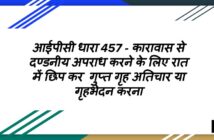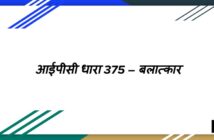During the pandemic and even during the recent riot, one of the most used terms was “Section 144”, but do you know what Section 144 of CrPC is, who imposes it and why is it imposed? This article will discuss Section 144 of the CrPC in detail.
What is Section 144 of CrPC?
Section 144 of the Code of Criminal Procedure, 1973 (CrPC) talks about the power to issue orders in urgent nuisance cases or apprehended danger.
Section 144 of CrPC has empowered the Magistrate of any state or union territory to pass an order restricting the gathering of more than four people in a particular area.
The main aim of the act is to maintain peace and order where there are chances of trouble, nuisance, or danger that can interrupt the regular human life or property. Therefore, it is anticipatory, i.e.; restrictions are imposed in case of an emergency where there is an apprehension of danger or disturbance of public peace and tranquillity.
This order can be passed against any individual or the general public.
Some instances where Section 144 was imposed:
- The most commonly used instance where Section 144 CrPC was imposed was during the pandemic, where a large number of people or groups of 4 or more people were not allowed to gather at one place at one time. Therefore, Section 144 of CrPC was imposed in many areas, including Mumbai, Delhi, Gurugram, etc., to curb the spread of Coronavirus when there was a rise in Covid-19 cases.
- Section 144 was imposed in the North Goa district when it received information about the possible terror attack on the western coast. Therefore, North Goa District Magistrate imposed Section 144 for 60 days.
- During the death anniversary of Afzal Guru and Maqbool Bhat, the government of Jammu and Kashmir blocked internet access by imposing Section 144 of CrPC in the state.
- Recently, prohibitory orders were imposed under Section 144 of CrPC near Roorkee by the administration of Uttarakhand’s Haridwar district.
- In Gautam Budh Nagar, Noida, Section 144 CrPC has been enforced from May 1- 31, 2022, in view of growing Covid-19 cases and upcoming festivals.
- In Hathras, Section 144 was imposed, preventing the entry of all ‘outsiders,’ including media, into the Boolgarhi village, where a Dalit girl was gang-raped.
- Section 144 was imposed in 2019 in Bhopal when the Ayodhya verdict was pronounced.
- Section 144 was imposed by the Karnataka government during the CAA and NRC protests that prohibited holding public meetings, carrying arms, and gathering five or more people in one place.
Features of Section 144 of CrPC
Section 144 of CrPC has the following features:
· Order passed under Section 144 of CrPC must be in writing.
· The order must specify the reason or material facts based on which the order is passed and its duration.
· The order should clearly state the prohibited acts or conduct and those prohibited from doing such acts or conduct.
What is prohibited under Section 144 of CrPC?
When the order under Section 144 of CrPC is passed following acts are prohibited or restricted:
· Handling or transporting any kind of weapons in a particular area or jurisdiction was restricted.
· No public or educational institutions will be working,
· There will be no rallies or public meetings when the order under this section is passed.
· Internet access is blocked.
Who can impose Section 144 of CrPC?
The State Government may empower the District Magistrate, a Sub-divisional Magistrate, or any Executive Magistrate to impose Section 144 of CrPC.
When can Section 144 of CrPC be imposed?
Section 144 can be imposed to prevent –
· Danger to the human life, safety, or health;
· disturbance to peace, public tranquillity, affray or riot; or
· obstruct, injure or annoy any person employed lawfully.
What are the grounds to impose restrictions under Section 144 of CrPC?
The State Government empowers the Magistrate to impose restrictions by a written order under Section 144 of CrPC on the following grounds, namely;
· Immediately preventing public nuisance; or
· When speedy remedy of apprehended danger is desirable.
It can direct the person to abstain from doing a certain act or take some order relating to a property in his possession or management by stating the material facts of the matter and serving a summon on them.
What is the duration for imposing Section 144 of CrPC?
Section 144 can be in force only for two months from the imposed date. However, suppose the State Government is of the opinion that it is necessary to protect human life, health, or safety or to prevent any affray or riot. In that case, it can direct the Magistrate to extend the order for a maximum of 6 months from the date the order expires.
The State Government or Magistrate can alter or rescind any order on an application made by the aggrieved person or on its motion. The aggrieved person will be heard on receiving the application, and the Magistrate will decide accordingly. If the application is rejected, the Magistrate must give its reason in writing.
What is the punishment for section 144 of CrPC?
Any person who is a part of ‘unlawful assembly shall be liable for ‘engaging in rioting’, which shall be punishable for three years. In addition, any person who prevents the police from performing his duty during the enforcement of section 144 shall also be punished.
The constitutional validity of Section 144 of CrPC
Section 144 of CrPC has given wide power to the Magistrate that restricts the fundamental right of the people. Therefore, the validity of this section has been challenged in many cases.
Madhu Limaye Vs Sub-Divisional Magistrate, Monghyr & Ors, 1971 AIR 2486, 1971 SCR (2) 711
The Court had held that merely because Section 144 of CrPC can be abused, it cannot be struck down if it is properly applied. The provision of the section is valid and constitutional as it is not in excess of the limits laid down by the Constitution for restricting the freedom guaranteed by it. There were some arguments between the two labour unions; therefore, the Magistrate passed a prohibitive order under Section 144 of CrPC to avoid any scuffle between the two labour union members. The order of the Magistrate was challenged on the ground of being arbitrary in nature.
The Court had held that the Magistrate is empowered to exercise this power only in case of emergency. This itself acts as a restriction on the Magistrate’s act. Therefore, no arbitrary power is given to the Magistrate and there is no abuse of power.
The Court had justified the constitutionality of Section 144 of CrPC by laying the following five points:
a) The Magistrate can pass ex-parte orders only in case of emergency. In such situations, the Magistrate must also serve a notice to the person against whom the order is passed.
b) The aggrieved person has the right to challenge the order of the Magistrate on the appropriate grounds, proving that the power is not arbitrary.
c) The aggrieved person is given an opportunity for a hearing. This proves the law of natural justice is also complied with.
d) The order passes or rejected will be based on the reason. This makes the action of the Magistrate reasonable.
e) Lastly, the order under Section 144 of CrPC is not appealable. However, the High Court has the power to either quash the order passed or ask the Magistrate to give material facts of the case. Thus, ensuring that the Magistrate is accountable.
In Re Ramlila Maidan Incident Case, 2012
The Court had criticized the government for using Section 144 of CrPC against the sleeping crowd in Ramlila Maidan. The Court had held that the Magistrate must detect and observe the situation and impose restrictions accordingly. There should not be any excessive restrictions either in nature or time and should strike a balance between the citizens’ rights and restrictions and rights and duties. The Court also stated that the restrictions should be reasonable, bona fide, and least invasive. It cannot be used to prevent citizens from peacefully using their fundamental rights.
What is the difference between section 144 and Curfew?
- Section 144 of CrPC restricts the gathering of 4 or more people in a particular area. Whereas, in Curfew, everyone is restricted into their house and no one is allowed to come out.
- Section 144 is imposed by District Magistrate, Sub-divisional Magistrate, or executive Magistrate, whereas, Collector and Police Commissioner can impose a curfew.
- In Section 144 of CrPC, all schools, colleges, markets, and offices are closed, whereas, during curfew all schools, colleges, markets, and offices are closed except for essential services such as banks, grocery stores, ATMs, vegetables, milk shops, etc. are open during a particular period with prior notice.
Conclusion
Section 144 of CrPC prohibits gathering four or more people in a particular area. It is imposed in urgent cases to prevent public nuisances or when there is a threat to public order, peace, or tranquillity. The State Government empowers the District Magistrate, Sub-divisional Magistrate, or Executive Magistrate to impose Section 144. Any person who is part of any unlawful assembly shall be punished with three years imprisonment. All the public offices, educational institutions, offices, and transport were shut during the issue of Section 144 of CrPC. Section 144 is different from the curfew. Section 144 restricts the assembly of more than four people, whereas; a curfew restricts the assembly of everyone at large.

